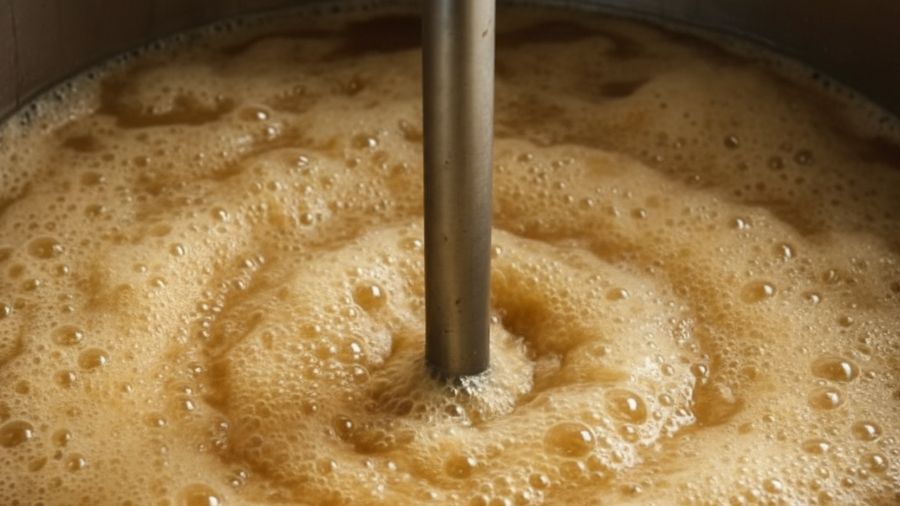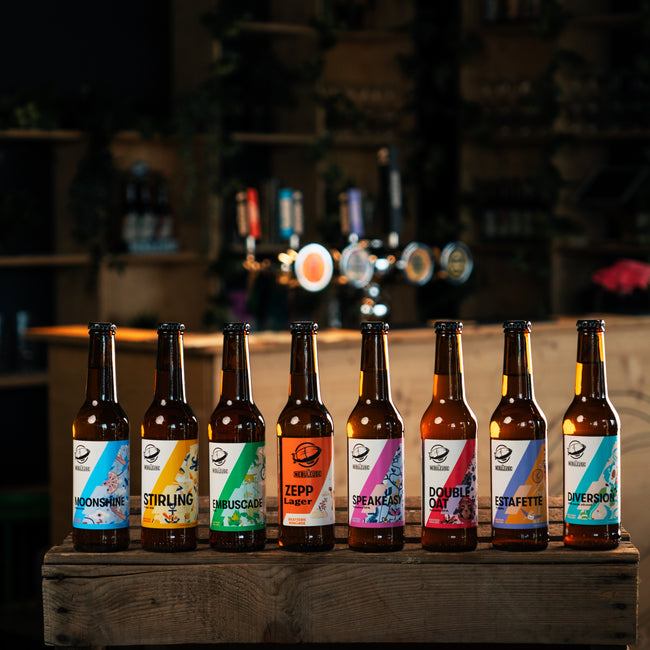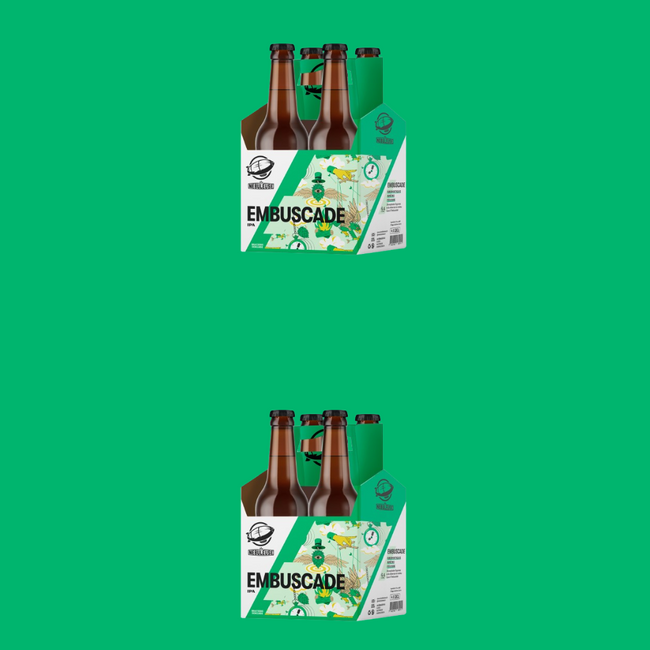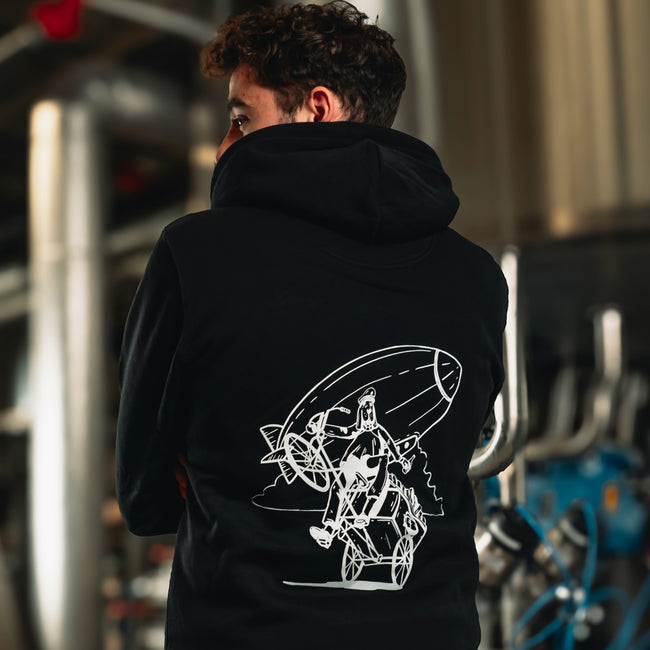Special fermentation techniques in craft beer

The magical transformation of a simple sweet wort into the sparkling, flavorful nectar that is beer. It's almost a miracle! Behind this apparent magic lies a fascinating process, the true conductor of all brewing creations: fermentation . Yes, that stage where yeasts party in your wort, transforming sugar into alcohol in a simple way... or not so simple.
If you thought all fermentations were equal, think again. In the world of craft brewing, fermentation isn't just a technical step. It's an extraordinary playground where the soul of beer is truly created. Temperature plays a key role in this modern alchemy, shaping the personality of your creation down to the smallest aromatic details.
While the industry standardizes this process to gain efficiency (and ordinariness), craft brewers are exploring the endless possibilities offered by specialty fermentation techniques. These unique approaches allow them to sculpt unique flavor profiles, play with textures, and create sensory experiences that make you raise an appreciative eyebrow from the first sip. And yes, your beer deserves better than being the result of fermentation rushed through in 72 hours flat.
The evolution of fermentation techniques: between tradition and innovation
From mysterious origins to scientific understanding
Beer fermentation likely originated as a happy accident several millennia ago. Picture the scene: damp grain left lying in the open air, wild yeasts wandering by, and suddenly. Surprise! A liquid with strangely pleasant effects. For centuries, this process remained shrouded in mystery, often attributed to divine forces or a form of alchemy.
It wasn't until the 19th century, thanks to the groundbreaking work of Louis Pasteur, that the veil was lifted on this phenomenon. By identifying yeasts as responsible for converting sugar into alcohol and CO2, Pasteur not only solved a centuries-old enigma, but also paved the way for a scientific understanding that would revolutionize the approach to brewing.
This discovery was quickly followed by the isolation of the first pure strains of yeast by Emil Christian Hansen in 1883, marking a fundamental shift: we moved from fermentation with unpredictable wild yeasts to a controlled process using specific strains, selected for their predictable characteristics.
The main fermentation families and their particularities
In the brewing world, we traditionally distinguish four main fermentation families, each with its own impact on the final aromatic profile.
Top fermentation : Produced with Saccharomyces cerevisiae yeasts that operate at temperatures between 15°C and 25°C, this method is characteristic of British ales, IPAs, Belgian beers, and many modern styles. This method generally produces beers with complex flavor profiles with pronounced fruity and spicy notes. Double Oat is a perfect example of what top fermentation can offer , with its tropical notes of mango and pineapple that come in part from the reaction between its US yeast and the oat flakes used in the brew. Hop bioconversion phenomena also play a crucial role, transforming certain compounds present in hops into new flavors.
Bottom fermentation : Conducted with Saccharomyces pastorianus yeasts that operate at cooler temperatures (7°C to 13°C), this technique characterizes lagers, pilsners, and other beers with more subtle aromas. This technique generally offers cleaner profiles that highlight the malts and hops. Zepp , a craft lager with delicate floral notes , is an excellent example of what perfectly controlled bottom fermentation can produce.
Spontaneous fermentation : Here, no yeast is intentionally added. The wort is exposed to the open air, in open cooling tanks (koelschip), allowing microorganisms present in the environment to naturally colonize the liquid. This ancestral Belgian method gives rise to lambics, gueuzes, and other tangy wonders that make the heads of thrill-seekers spin. It produces beers of unparalleled complexity , with notes that are often tangy, fruity, and "funky"—to use the jargon of connoisseurs.
Mixed fermentation : This approach combines the use of conventional brewer's yeast with other microorganisms such as Brettanomyces, Lactobacillus, or Pediococcus. It produces complex profiles that evolve considerably over time. American sour beers, some saisons, and modern sours often employ this technique, creating beverages with wild but controlled characters.
Craftsmanship versus industrialization
The industrialization of brewing led to a massive standardization of fermentation techniques. In a drive for productivity and reproducibility, large brewing groups adopted highly controlled processes, aiming for uniformity rather than singularity. Fermentation became a simple link in the production chain, subject to the imperatives of speed and efficiency.
Contrary to this approach, craft breweries like La Nébuleuse value fermentation as a creative space where the essence of a beer's identity is played out. Far from being a simple technical step, fermentation is considered the beating heart of the brewing process, a crucial moment where the aromas and flavors that will become the signature of a creation develop.
This artisanal vision is part of a form of reappropriation of traditional know-how, enriched by modern scientific knowledge. By restoring the nobility of this fundamental step, artisan brewers are constantly reinventing their craft, transforming each brew into a unique expression of their creativity. Because no, fermentation isn't just a necessary evil to produce alcohol; it's the beating heart of your next taste experience.
Temperature control: the delicate art of sculpting aromas
The impact of temperature on yeast metabolism
If yeast were a musician, temperature would be its conductor. Every variation, however small, profoundly influences how the yeast transforms the must placed before it. This wort, the result of the meticulous transformation of barley into a fermentable substrate , then becomes the raw material for this fermentation alchemy. Suffice it to say that the thermometer is not a gadget in a craft brewery, it is the equivalent of a maestro's baton.
At low temperatures , the yeasts work slowly and methodically, producing few esters and phenols – the compounds responsible for fruity and spicy notes. The result? Beers with a "clean" profile, where malts and hops express themselves clearly. This is the preferred approach for lagers like Zepp , where low-temperature fermentation allows the delicate floral aromas of noble hops to express themselves without interference.
Conversely, in top fermentation, higher temperatures stimulate the production of fruity esters and sometimes spicy phenols. The more active yeasts generate more aromatic by-products. The Ambush , with its frank aromas of blood orange and resin, owes part of its character to this controlled top fermentation which amplifies the expression of American hops. The enzymatic activity of the yeasts and the fermentation kinetics play a decisive role here in the development of the final profile. A true microbial ballet orchestrated with precision.
But temperature isn't just a matter of "high" or "low"—it's a whole spectrum of possibilities. Brewers are increasingly exploring "temperature excursion profiles," intentionally varying the temperature at different stages of fermentation to achieve more complex flavor palettes.
Control equipment: from the cool cellar to precision thermoregulation
The history of temperature control in brewing is also the story of the technological evolution of the craft. Our brewing ancestors relied on the seasons and architecture—cool cellars, warm attics—to maintain proper fermentation conditions. Beer was thus a seasonal product, with certain styles only brewable at certain times of the year.
The invention of mechanical refrigeration in the 19th century revolutionized this aspect of brewing, making it possible to produce lagers year-round. But it was truly the modern era that democratized precision temperature control systems, making a level of control once reserved for large industrial groups accessible to microbreweries.
Today, a craft brewer has an impressive range of options: from double-walled fermenters with glycol circulation, dedicated cold rooms, immersion heating systems, to smart tanks capable of automatically following programmed thermal profiles.
This technical mastery allows for creative approaches like the "cold fermentation" of Saisons and Farmhouse Ales, where fermentation started at room temperature is gradually cooled to extract unique rustic flavors. Or the "hot pitch" of certain New England IPAs, where the wort is pitched at an abnormally high temperature to stimulate the production of specific esters, before being rapidly cooled to prevent unwanted flavors. But be careful, this creativity requires constant vigilance: poor control can quickly tip a promising creation into defects that sabotage your best craft beers.
Even more radical alternative methods are beginning to emerge, challenging traditional processes. Precisely managing oxygenation during fermentation represents another fascinating area of exploration for craft brewers, directly influencing yeast health and the production of specific flavor compounds.
Creative thermal profiles: when temperature becomes a tool for expression
Beyond simply maintaining a constant temperature, craft brewers are exploring complex "thermal journeys" that radically transform the character of their creations.
Consider a technique popular among contemporary Belgian beer makers: the "step-up fermentation profile." Fermentation begins at a relatively low temperature (18-19°C) for the first 24 to 48 hours, during which time the essential aromatic precursors are formed. Then the temperature is gradually increased to 23-25°C for the final days, stimulating the production of fruity esters and ensuring complete attenuation. This balanced approach produces beers like Estafette . , this Belgian triple with fruity aromas of banana and apricot which nevertheless retains a remarkable finesse.
At the opposite end of the spectrum, some lager brewers are experimenting with "diacetyl rest" —a temporary temperature increase at the end of the main fermentation that allows the yeast to "clean up" some unwanted compounds like diacetyl before the beer is cold brewed. This technique contributes to the crystal-clear clarity and aromatic purity of some craft lagers.
The future of thermal profiles seems limitless: avant-garde brewers are already experimenting with algorithms that adjust temperature in real time based on fermentation activity, or thermal cycles inspired by the day/night variations that are thought to have affected historical fermentations. A true microbial clockwork that pushes the boundaries of what is possible.
The Magic of Yeast: Choosing, Mixing, and Hybridizing Strains
The "personalities" of different yeast strains
If you thought yeasts were just simple microorganisms that convert sugar into alcohol, think again. Each yeast strain has a unique "character ," shaped by millions of years of evolution.
Belgian abbey yeast, like the one used for Estafette , is distinguished by its generous production of fruity esters (banana, apricot) and spicy phenols (clove, pepper), creating complex profiles even with relatively simple recipes. American "clean" yeasts, favored for IPAs like Embuscade , are more discreet, highlighting the hops while adding a light fruity touch. As for lager yeasts, they excel in the art of discreet fermentation, producing few by-products to allow the purity of the raw materials to express themselves.
This diversity isn't limited to cultivated species. In the wild, yeasts like Brettanomyces contribute funky notes of leather, overripe pineapple, or wet hay that can radically transform a beer. Traditional Scandinavian strains like Kveik defy established rules by fermenting at surprisingly high temperatures (up to 40°C) without producing the off-flavors usually associated with these conditions.
Microbial blends and cocktails and creating symphonies of flavors
Why limit yourself to just one strain when you can use several? This question paved the way for one of the most creative trends in modern brewing: the use of yeast blends.
The "co-pitching" technique involves simultaneously inoculating different Saccharomyces strains, each contributing its own characteristics to the final profile. These blends can combine British ale yeasts for their fruity esters with American strains for their attenuating power, creating profiles impossible to achieve with a single strain.
Even more complex, mixed fermentation or "mixed culture" integrates different types of microorganisms—conventional yeasts, Brettanomyces, lactic acid bacteria—into a microbial ecosystem that evolves over time. This approach, inspired by traditional Belgian methods, allows for the creation of slow-maturing beers with exceptional aromatic depth.
The most adventurous brewers go so far as to "sequence" their pitches, adding different strains at specific points during fermentation. For example, starting with a classic ale yeast to establish a base profile, then adding Brett to develop wild complexity during maturation. This microbial choreography allows for unparalleled creative precision. Progressive pitching and sequential fermentation techniques open up a whole universe of possibilities for brewers who wish to explore the fourth dimension of beer creation: time.
Pressure fermentation: how to shape esters without affecting temperature
A particularly interesting technique that is gaining popularity is pressure fermentation. This process involves maintaining a counterpressure of CO₂ in the fermenter during the active phase of fermentation.
This additional pressure alters the yeast's metabolism, reducing the production of esters and volatile compounds even at higher temperatures. In practice, this makes it possible to ferment a lager at an ale temperature (15-18°C instead of 8-12°C) while retaining the aromatic sharpness characteristic of low-temperature fermentations – a considerable saving in time and energy.
The technique also finds application in ales, allowing the "calming" of normally very expressive strains or the creation of hybrid profiles between lagers and ales. This approach is particularly relevant for emerging styles such as IPL (India Pale Lager) which seek to combine the sharpness of a lager with the aromatic expressiveness of an IPA.
Innovative breweries are even exploring variable pressure profiles during fermentation. Starting at atmospheric pressure to allow for initial flavor expression, then gradually increasing pressure to refine the profile. This further demonstrates the ability of craft brewers to transform technical constraints into creative opportunities. Advances in the molecular understanding of fermentation processes now allow brewers to design precisely calibrated fermentation protocols to achieve the exact flavor profiles desired.
Secondary fermentations and conditioning
Bottle refermentation: a living tradition
Far from being over after the main fermentation, the microbial adventure can continue directly in the bottle thanks to refermentation – a technique that radically transforms the character of the beer and its perception in the mouth.
This traditional method, particularly associated with great Belgian and Trappist beers, involves adding a small amount of sugar and often fresh yeast at the time of packaging. Much more than simple carbonation , this second fermentation life radically transforms the texture in the mouth and the overall tasting experience.
Refermentation creates a distinctive texture in the mouth, with finer, more persistent bubbles that carry aromas differently. It also allows the beer to evolve over time, as the yeast continues to work slowly, gradually releasing new aromatic compounds and absorbing oxygen—thus protecting the beer from oxidative aging.
Beers like Estafette benefit greatly from this approach, developing additional complexity after a few months of aging , with apricot notes deepening and a roundness asserting itself on the palate. The mechanisms of gradual release of aromatic compounds by yeasts in the bottle and their interaction with the evolution of complex residual sugars represent an exciting area of study for brewers seeking to master the art of living conditioning.
Open barrels and fermenters: the influence of the container
The container in which fermentation takes place profoundly influences the final character of the beer, not only through its shape, but also through the microorganisms it can host and the chemical interactions it allows.
Traditional open fermenters , such as British Yorkshire squares or Belgian shallow tanks, promote specific gas exchange and a unique aromatic expression. Their specific geometry influences the formation of krausen (the fermentation foam) and the reabsorption of certain compounds, while their openness allows for slight contact with the surrounding air – creating a profile impossible to reproduce in a closed system.
As for fermentation in wooden barrels , it represents one of the most exciting frontiers in contemporary brewing. These living containers harbor their own microbial ecosystems and allow for subtle exchanges with the environment. A barrel that has contained wine will not only contribute tannic or fruity notes, but also wine yeasts that can contribute to fermentation. A whisky barrel will offer notes of vanilla, caramel, and oak that will blend with the beer's profile, creating a complexity impossible to achieve by other means.
Pioneering breweries are even creating their own "solera cask" programs , inspired by sherry aging methods, where only a portion of each cask is racked, then topped up with younger beer. This creates a perpetual aging system that generates profiles of remarkable complexity. This approach raises fascinating questions about microbial interactions in fermentative ecosystems established over several years, and how these communities evolve to create sensory profiles impossible to replicate by other means.
Aging and Evolution: Designing Beers That Improve with Time
Contrary to the industrial dogma that beer should always be drunk cold, some artisanal creations are designed to flourish over time , like great wine vintages.
This approach requires a special design from the start: recipes that are generally higher in alcohol to serve as a natural preservative, a hop profile that anticipates the transformation of aromatic compounds over time, and often fermentation techniques that deliberately leave complex sugars that will take yeast months or years to gradually degrade.
Mixed-fermentation beers are particularly well-suited to this evolution. In these creations, the different microorganisms work at different rates: conventional Saccharomyces quickly ferments simple sugars, then passes the baton to Brettanomyces, which slowly breaks down more complex sugars. The latter can remain active for years, gradually transforming the beer's profile, which gains in complexity.
Other creations, such as barleywines or imperial stouts, can age majestically even without continuous fermentation. In these cases, it is the chemical evolution of existing compounds that gradually transforms the profile: controlled oxidation of certain higher alcohols, formation of new complex esters, and that fascinating metamorphosis of bitterness that gradually softens initially sharp beers.
This temporal dimension adds an extra depth to the art of brewing , transforming certain beers into true time capsules that tell, with each tasting, a fascinating evolutionary story. The study of the biochemical processes involved in the aging of beers and the evolution of their organoleptic properties represents an exciting frontier of modern brewing research, at the intersection of chemistry, microbiology and sensory analysis.
Fermentation as the signature of a craft brewery
In the standardized world of industrial production, specialized fermentation techniques represent a tremendous space of freedom and expression for craft brewers. Much more than a simple technical step, fermentation has become the distinctive signature which allows each brewery to reveal its personality and vision. This is where the real difference lies between a beer you forget and a creation you ask for again. Between a drink that quenches your thirst and an experience that takes you on a journey.
This philosophical approach to fermentation marks a fundamental break with the industrialization that has long dominated the sector. Where large groups seek efficiency and uniformity, the artisan brewer values singularity and authenticity. Fermentation is no longer seen as a simple means of producing alcohol, but as the beating heart of a unique brewing creation.
Consumers, increasingly knowledgeable, recognize and appreciate this difference. They are no longer looking for just a standardized beer, but an authentic sensory experience that tells a story , bears the signature of a place and a creator. Special fermentation techniques, with the aromatic richness they generate, perfectly meet this expectation of originality and character. Because, deep down, who wants to drink the same thing as everyone else?
As the craft movement continues its global expansion, creative approaches to fermentation are constantly being shared, hybridized, and evolved. From centuries-old Belgian traditions to the innovations of American brewers, from rediscovered Nordic techniques to cutting-edge microbial experiments— brewing fermentation is experiencing a veritable golden age of creativity.
In this effervescent landscape of innovation, each brewery finds its way, develops its methods and refines its fermentation signature. For La Nébuleuse , this approach translates into a range where each creation expresses its own personality, while sharing a common DNA of audacity and uncompromising quality. Because at its core, mastering special fermentation techniques means fully embracing the magical transformation that turns a simple wort into a unique creation – this fascinating alchemy that, for millennia, has transformed cereals into moments of conviviality and shared pleasure.









